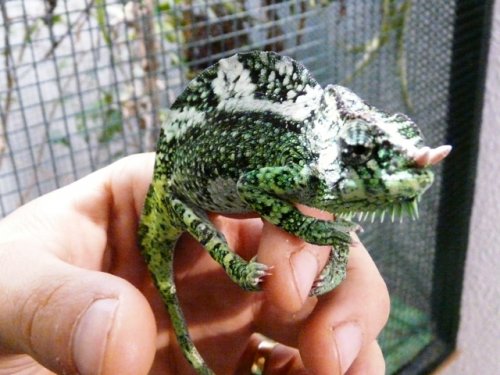Navigation
Install the app
How to install the app on iOS
Follow along with the video below to see how to install our site as a web app on your home screen.
Note: This feature may not be available in some browsers.
More options
You are using an out of date browser. It may not display this or other websites correctly.
You should upgrade or use an alternative browser.
You should upgrade or use an alternative browser.
my trioceros family
- Thread starter celine
- Start date
merumontanus
Avid Member
Celine,
What gorgeous animals. Can you tell me more about your jacksonii? The first female and the male in the last photo are clearly xantholophus, but the female in copulation has a truly enlarged rostral horn-- which is more atypical of xantholophus (except, of course, in African intergrades and those of hawaiian origin). Can you show another photo of the female? It looks more like a jacksonii jacksonii to me from this angle. Are you in the Americas?
Is the male hoehnelii the only one you have?
Cheers,
Fabián
What gorgeous animals. Can you tell me more about your jacksonii? The first female and the male in the last photo are clearly xantholophus, but the female in copulation has a truly enlarged rostral horn-- which is more atypical of xantholophus (except, of course, in African intergrades and those of hawaiian origin). Can you show another photo of the female? It looks more like a jacksonii jacksonii to me from this angle. Are you in the Americas?
Is the male hoehnelii the only one you have?
Cheers,
Fabián
merumontanus
Avid Member
@fabian
i m from France(sorry for my english).
it s a xantholophus jackson with unicor she s 11 month olds
the first pic is her mother
for hoenhelii i ve another young male look pic
if you have infos on hoenhelii i ll take it
Celine,
I can assure you that your English is superb compared to my French-- one day I'll learn...
Thanks for the additional photos! The second hoehnelii is absolutely amazing! It looks like a lowland hoehnelii to me, whereas the first one looks like the animals that come from higher elevations in Kenya. Did you acquire them each at different times?
You also mentioned that the "unicorn" jacksonii is 11 months old and that its mother is the large female in the first photo, but then you say in your last post that the ("unicorn") female came from Hawaii. If this is the case, how do you know her mother is the female in the first photo?
The reason I questioned the identity of the "unicorn" female is because it seems to have some traits that fit the description of jacksonii jacksonii, or an intergrade between jacksonii jacksonii and jacksonii xantholophus, not just because of the presence of the rostral horn, but because of its pronounced size and significant annulation. The fact that you are also in Europe, where jacksonii jacksonii is much more common than xantholophus, is another reason for suspicion.
Either way, you have a very healthy group and I'm so glad you had a chance to share the photographs.
Cheers!
Fabián
P.S. Let me know if my questions are confusing...
Cainschams
New Member
They all look great!!!! Especially the little hoes
Especially the little hoes
Cainschams
New Member
@fabian
i m from France(sorry for my english).
it s a xantholophus jackson with unicor she s 11 month olds
the first pic is her mother
for hoenhelii i ve another young male look pic
if you have infos on hoenhelii i ll take it
I also meant to say that you might want to contact Chuck G on the forums. I know he has experience with this species. He also loves to share info
the gravid female was exported from hawaii i bought it in paris 2 years ago it s strange because she s not unicorn!!
the unicorne is her daugther
for hoenhelli the second is cb he come from deutsland and got 6 months old
the first is wc and come from Kenya....I m lookink for female
the unicorne is her daugther
for hoenhelli the second is cb he come from deutsland and got 6 months old
the first is wc and come from Kenya....I m lookink for female
merumontanus
Avid Member
the gravid female was exported from hawaii i bought it in paris 2 years ago it s strange because she s not unicorn!!
the unicorne is her daugther
for hoenhelli the second is cb he come from deutsland and got 6 months old
the first is wc and come from Kenya....I m lookink for female
Ah, I see. Well, it's not that strange then to see the female with such a large rostral horn. There are those who have hypothesized these "abnormalities" in Hawaiian jacksonii as the result of inbreeding on the islands, as well as the possibility that some of the original animals may have been intergrades of j.jacksonii and xantholophus in the first place, which may be why you see so much red in some of the animals of Hawaiian origin.
Here are a couple of hoehnelii I kept a while back-- they were quite a challenge to keep here in Texas, but then again, so are all my jacksonii.
Cheers!
Fabián
Captive-born

Adult male

Adult male

Adult female

Similar threads
- Replies
- 28
- Views
- 5K
- Replies
- 4
- Views
- 871









